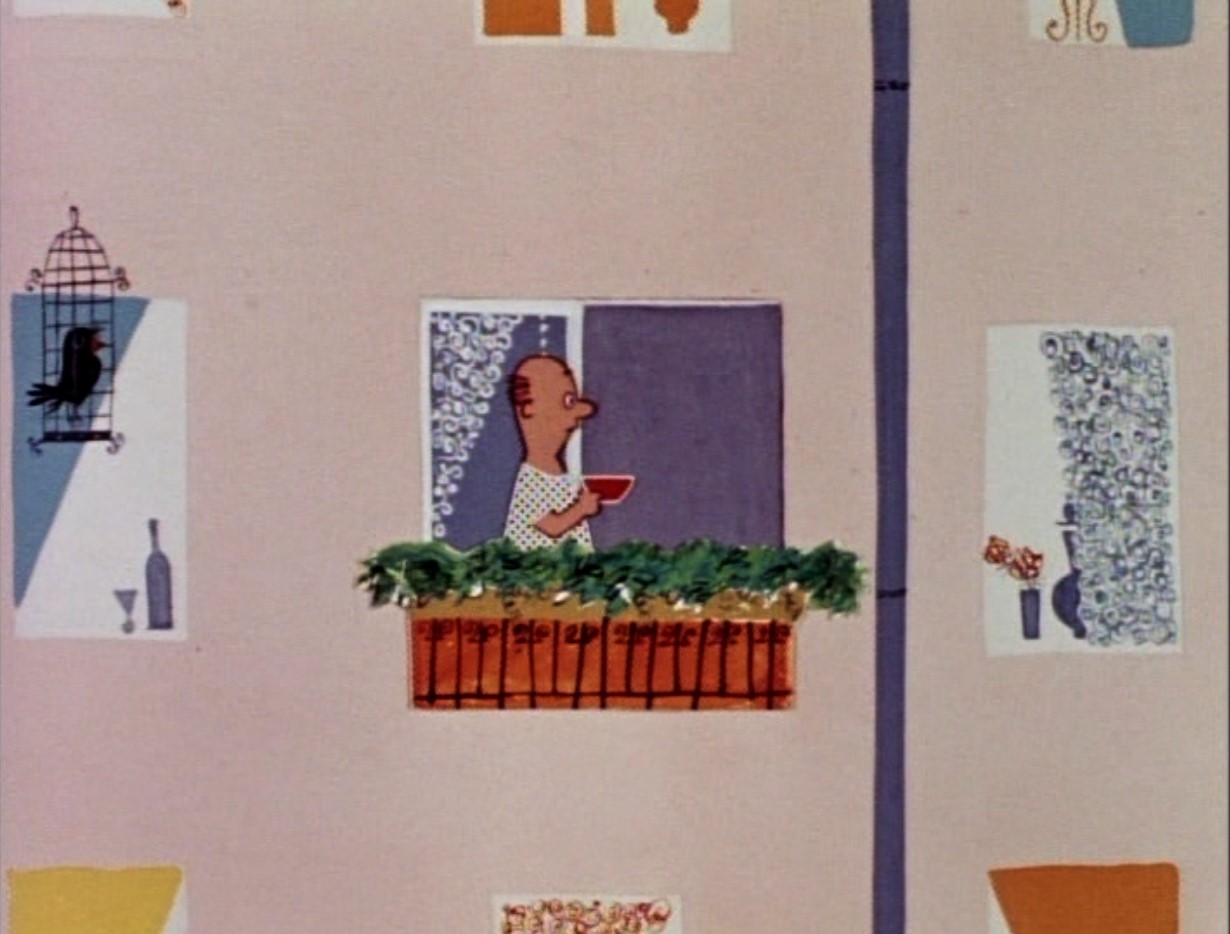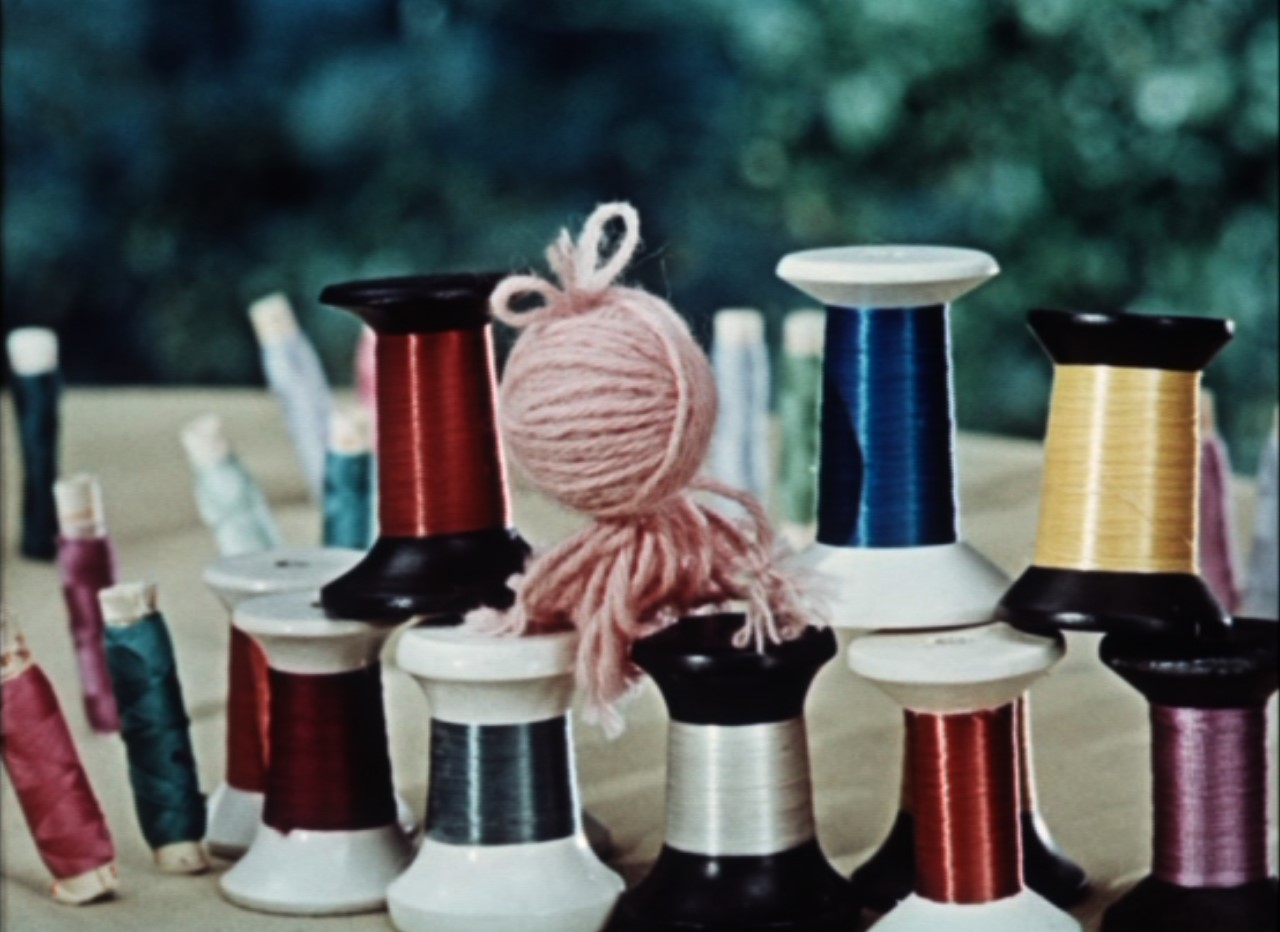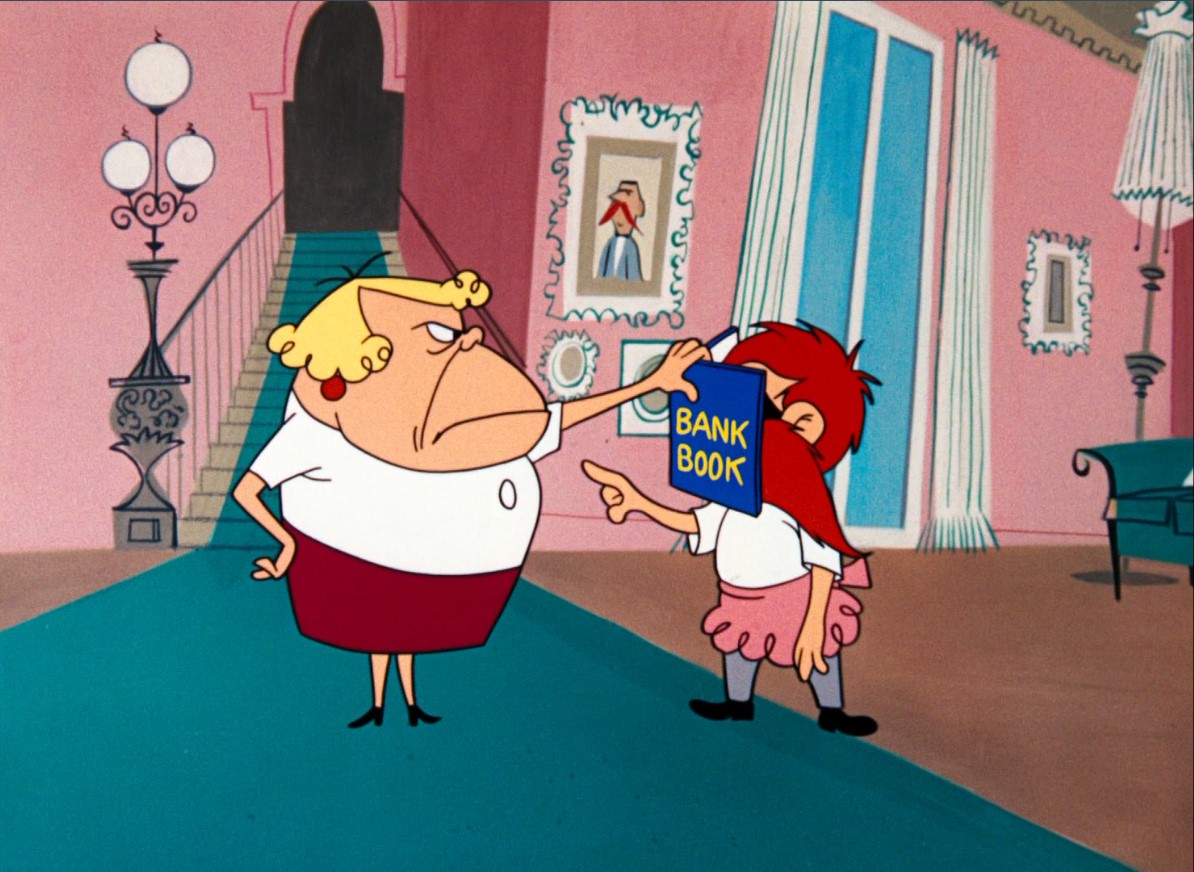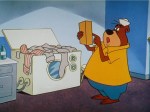You are currently browsing the tag archive for the ‘1962’ tag.
Director: Osamu Tezuka
Release date: November 1962
Rating: ★★★
Review:

‘Tales of a Street Corner’ was Osamu Tezuka’s first animated film, and the first production of his company Mushi productions, which Tezuka founded in 1961, after his contract ended at Toei Animations, Japan’s most important animation studio of that time.
The film immediately shows Tezuka’s high ambitions. First, ‘Tales of a Street Corner’ is of considerable length, clocking 39 minutes. Second, its designs echo the cartoon modern style of Europe, unlike anything previous in Japan. Third, Tezuka’s storytelling is highly poetical, reminiscent of Paul Grimault, avoiding tried story cliches. Fourth, the film has a strong anti-militaristic and pacificist tone, and is more than just mere entertainment.
It’s striking to note that, unlike Tezuka’s Astro Boy television series from a year later, ‘Tales of a Street Corner’ lacks any Japanese character. Instead, the film feels very European, both in its looks and in its music. Even the town in which the story takes place is clearly European, as are the poster violinist and pianist. These two characters form the heart of a romantic tale that Tezuka spins, with other protagonists being a little mouse, a moth, and even a broken lantern and a tree.
The whole tale is set in motion when a little girl drops her teddy bear in a gutter, but Tezuka’s story is anything but straightforward, and allows for some poetic moments, as well two series of silly gags involving numerous posters. The animation ranges from full animation to zooming into still images, with everything in between, and it is quite possible that Tezuka’s choices in the complexity of animation were motivated not only by its artistic value, but also by cost reduction.
‘Tales of a Street Corner’ is certainly charming, but as would later be more often the case with Tezuka, the director wants too much within one short. In fact, the short is overlong, and it’s unclear what he wanted the resulting film to be: a children’s film? A romance? A comedy? An anti-war statement? Now, the film is all this and thus none of that at the same time. Nevertheless, ‘Tales of a Street Corner’ remains a delight to look at throughout, and with this film Japan surely entered a new phase in animation, even if the film is still copying its European models.
Watch ‘Tales of a Street Corner’ yourself and tell me what you think:
‘Tales of a Street Corner’ is available on the DVD ‘The Astonishing Work of Tezuka Osamu’
Director: Fyodor Khitruk
Release date: 1962
Rating: ★★★★
Review:

‘Story of One Crime’ was the first film directed by acclaimed film maker Fyodor Khitruk (1917-2012). Khitruk was one of the best comic talents in the Soviet era, as is already visible in this delightful early film.
The short starts with a man sneaking upon two talking ladies and hitting them with a large pan. At that point the narrator interrupts and takes us viewers 24 hours back. The rest of the film is told wordlessly, and shows the criminal, comrade Manin, to be a nice, gentle and hard working man. We watch him going to work, and working at the office.
All seems well, but as soon as he returns to his home, in an apartment block, the problems start. When he wants to rest on his balcony, he’s disturbed by ridiculously loud domino players playing in the courtyard. When he returns inside to watch some television, a neighbor turns on some loud jazz music, and later, when he tries to sleep, more neighbors deprive him of a good night’s rest in various ways. The film ends with a message to the viewers themselves, no doubt, more often than not living in such noisy apartments themselves.
Khitruk tells his tale with an understated sense of humor, and a relaxed, but effective sense of timing. The animation is limited, and far from fluent, but as Khitruk knows how to pose, very effective. The designs by Sergei A. Alimov, too, are a delight: the film is a rare example of Soviet cartoon modern design, and both characters and backgrounds are gorgeous throughout the film. They are partly made by snippets from magazines, and especially the neighbor’s gargantuan stereo installation is a great example of good cut and paste work.
With ‘Story of One Crime’ Khitruk took Soviet animation away from the classic fairy tale worlds of the 1950s into the modern age. The film contains some criticism on Soviet society, which is depicted as less than ideal, but the film was an enormous success, nonetheless.
With this short Khitruk immediately became one of the Soviet Union’s most important animation film makers, as he would prove, e.g. by delivering the world his delightful ‘Vinnie Puch’ (Winnie the Pooh) films of 1969-1972.
Watch ‘Story of One Crime” yourself and tell me what you think:
‘Story of one Crime’ is available on the DVD ‘Masters of Russian Animation Volume 1’
Director: Hermína Týrlová
Release date: 1962
Rating: ★★★
Review:

In ‘Two Balls of Wool’ the insides of a sewing box come to life, including a scissors, a measuring tape, thread spools, a horse-like pincushion, and, most importantly, two balls of wool.
The pink ball of wool turns into a girl, while the blue one turns into a boy. The boy plays the flute on a needle, charming the measuring tape, who acts like a snake. When the snake captures the girl, the boy comes to the rescue, riding the pincushion horse. The two also perform some acrobatic tricks, and accidentally unwind a knitted piece, until the scissors forces them to knit the piece back again
The film has a rather weak story, but it’s a marvel how Týrlová spins a film out of such ordinary material, making use of the properties of these objects. The animation is top notch. For example, note how Týrlová manages to turn the scissors (which can’t do anymore than the scissors in your drawer) into an authority figure, imposing on the other objects. ‘Two Balls of Wool’ thus is a charming little short, showing Týrlová’s great talent as an animator.
Watch ‘Two Balls of Wool’ yourself and tell me what you think:
https://noodlemagazine.com/watch/-167471844_456240845
‘Two Balls of Wool’ is available on the DVD box ‘Hermína Týrlová Výběr z tvorby/Selected Works’
Director: Friz Freleng
Release date: September 1, 1962
Stars: Yosemite Sam
Rating: ★★
Review:

‘Honey’s Money’ opens with Yosemite Sam reading about a local widow inheriting five million dollars. He sets out to court the lady immediately, and marries her too, despite the fact that she is ugly. But married life isn’t what Sam had expected, and then he has to meet his oversized baby son Wentworth…
‘Honey’s Money’ is a remake of the earlier Friz Freleng cartoons ‘His Bitter Half’ (1950) and ‘Hare Trimmed’ (1953). The short is noteworthy for being Yosemite Sam’s only solo cartoon, and only one of two not co-starring Bugs Bunny, the other one being ‘Along Came Daffy’ from 1947.
Unfortunately, the short can hardly be called a classic within the Looney Tunes canon: Yosemite Sam is particularly unpleasant in this short, his sole motive being greed. And as he apparently can’t even spend the money, this motive becomes a muddled one. Moreover, the character designs and animation are only fair, and the gags mediocre.
One thus has ample time to admire Hawley Pratt’s layouts and Tom O’Loughlin’s background art, which form the highlight of an otherwise run-of-the-mill cartoon. Another highlight is the card crediting Friz Freleng, which features a caricature of the director on a dollar bill.
Watch ‘Honey’s Money’ yourself and tell me what you think:
‘Honey’s Money’ is available on the Blu-Ray and DVD ‘Looney Tunes Platinum Collection Volume Three’
Director: Kazimierz Urbański
Release date: 1962
Rating: ★★
Review:

‘Playthings’ is a film on fighting. The film knows only monochrome yellow and red backgrounds and silhouetted, abstracted human figures and weapons.
The film starts with some designs based on ancient cave paintings. We watch a group of human figures hunt a deer. When one is killed, another group of more tangram-like humans, arrives, and the fighting starts, with more and more advanced weaponry, like cannons, machine guns, tanks, bomber planes. As can be expected, in the end everybody is killed by a giant, probably nuclear explosion. The message of ‘Playthings’ is crystal clear, but the short is too one-dimensional to make a lasting impression.
Watch ‘Playthings’ yourself and tell me what you think:
‘Playthings’ is available on the DVD-set ‘Anthology of Polish Animated Film’
Director: Gene Deitch
Release Date: December 1962
Stars: Tom & Jerry
Rating: ★
Review:

‘Carmen Get It’ opens with a busy New York street scene. From here Tom chases Jerry into the Metropolitian opera house, where a performance of Georges Bizet’s opera ‘Carmen’ is about to start.
The rest of the cartoon takes place within the opera setting, during the playing of the Carmen overture, and a little bit of the opera itself. Unfortunately, the whole cartoon is terribly tiresome and unfunny, making ‘Carmen Get It’ probably the worst of all concert cartoons. This is a sad irony, because Tom & Jerry are also responsible for one of the all time best: ‘The Cat Concerto‘ (1947).
Particularly annoying is the conductor, who is clearly modeled after Arturo Toscanini (1867-1957), but so badly designed and so awfully animated he get on one’s nerves. Steven Konichek’s music, meanwhile, tries to get an American flavor by mixing ‘Yankee Doodle’, ‘Dixie’ and ‘There’ll Be a Hot Time in the Old Town Tonight’ into the music. The latter tune was most probably still under copyright at the time, but I wonder if anyone noticed.
‘Carmen get it’ was the last of the Gene Deitch Tom & Jerries, a poor and unfunny series of cartoons, which during their short existence never came even within a reasonable distance of the quality of the original ones by Hanna and Barbera. Gene Deitch had outlasted its welcome within one year and moved over to produce cartoons for Paramount, directing a.o. Popeye and Krazy Cat cartoons.
Tom & Jerry were already revived once again the next year, by Chuck Jones, whose Tom & Jerry cartoons were to be a great improvement on Gene Deitch’s ones, albeit nowhere near the classic Hanna-Barbera cartoons…
Watch an excerpt from ‘Carmen Get It’ yourself and tell me what you think:
This is Tom & Jerry cartoon No. 127
To the previous Tom & Jerry cartoon: Buddies Thicker than Water
To the next Tom & Jerry cartoon: Penthouse Mouse
‘Carmen Get It’ is available on the DVD-set ‘Tom and Jerry – The Gene Deitch Collection’ and the European DVD-Box ‘Tom and Jerry Collection’
Director: Gene Deitch
Release Date: November 1962
Stars: Tom & Jerry
Rating: ★★
Review:

In ‘Buddies Thicker than Water’ Jerry has it made, living in a luxury penthouse on the top of a huge skyscraper. Meanwhile Tom is freezing in the snow below.
Tom calls his former foe for help and Jerry is willing to take him in. But Tom double-crosses his savior and in return the mouse haunts Tom out of the house.
This cartoon has got one of the best and most straightforward stories of all Gene Deitch’s Tom & Jerry cartoons, which makes it stand out of the series. Unfortunately the short is very low on gags, and the animation and staging are very poor, as always in Gene Deitch’s Tom and Jerries. I guess the cartoon’s highlight is the modernly designed interior of the apartment.
Watch an excerpt from ‘Buddies Thicker than Water’ yourself and tell me what you think:
This is Tom & Jerry cartoon No. 126
To the previous Tom & Jerry cartoon: Sorry Safari
To the next Tom & Jerry cartoon: Carmen Get It
‘Buddies Thicker than Water’ is available on the DVD-set ‘Tom and Jerry – The Gene Deitch Collection’ and the European DVD-Box ‘Tom and Jerry Collection’
Director: Gene Deitch
Release Date: October 1962
Stars: Tom & Jerry
Rating: ★
Review:

In ‘Sorry Safari’ we meet the fat man from ‘Down and outing‘ and ‘High Steaks‘ for the last time. In this cartoon he is on a safari in Kenya.
Tom and Jerry perform uninspired antics reminiscent of the former two cartoons. Never sympathetic in the Gene Deitch cartoons, Jerry is particularly nasty in this one. The whole affair is a tiresome watch and one has ample time to gaze at the charming cartoon modern background art of the jungle. The cartoon’s only highlight is its strangely designed elephant.
But notice the piece of animation when Tom tries to get Jerry out of one of the guns: suddenly he looks and moves like his old self again. This sequence does only last a second, but how did the marvel get in there? Did the animator trace a Hanna-Barbera cartoon for just these few frames? I guess we’ll never know.
Watch ‘Sorry Safari’ yourself and tell me what you think:
This is Tom & Jerry cartoon No. 125
To the previous Tom & Jerry cartoon: Tall in the Trap
To the next Tom & Jerry cartoon: Buddies Thicker than Water
‘Sorry Safari’ is available on the DVD-set ‘Tom and Jerry – The Gene Deitch Collection’ and the European DVD-Box ‘Tom and Jerry Collection’
Director: Gene Deitch
Release Date: September, 1962
Stars: Tom & Jerry
Rating: ★★½
Review:

‘Tall in the Trap’ is a typical Tom and Jerry chase, brought as a classic western.
The talkative sheriff and cheese shop owner could be missed, but luckily most of the cartoon is devoted to the silent comedy of Tom and Jerry themselves. Co-written by Tedd Pierce at least the gags are good, even if their execution is not. The best gag undoubtedly is the light switch and stairs gag, but this one is ‘borrowed’ straight from the Bugs Bunny cartoon ‘Windblown Hare’ (1949). In fact, the most enjoyable aspects of this cartoon are its opening credits and Steven Konichek’s soundtrack, which for once is scored for solo guitar only (played by George Jirmal). Unfortunately, the Czech composer’s melodies sound more Viennese than American, and add little to the Western atmosphere.
Watch and excerpt from ‘Tall in the Trap’ yourself and tell me what you think:
This is Tom & Jerry cartoon No. 124
To the previous Tom & Jerry cartoon: The Tom and Jerry Cartoon Kit
To the next Tom & Jerry cartoon: Sorry Safari
‘Tall in the Trap’ is available on the DVD-set ‘Tom and Jerry – The Gene Deitch Collection’ and the European DVD-Box ‘Tom and Jerry Collection’
Director: Gene Deitch
Release Date: August, 1962
Stars: Tom & Jerry
Rating: ★★★½
Review:

‘The Tom and Jerry Cartoon Kit’ is based on an original idea and this makes the short arguably the best of the Gene Deitch Tom & Jerry cartoons.
Nevertheless, the initial idea of a ‘Tom and Jerry cartoon kit’ is badly developed, as it is based on two extended gag routines: one featuring water melon seeds, and another focusing on Jerry’s judo skills (which the animators confuse with karate).
The cartoon is rescued by some clever gags and by daring monochrome featureless backgrounds, creating a fairly surreal atmosphere. The dancing animation, too, is nice to watch, and the montage in which Tom learns boxing is well-timed for a change. Moreover, this short contains probably the most original gag of all Gene Deitch’s Tom & Jerry cartoons: the one in which Tom’s thinking process makes his eyebrows knit a sweater.
Watch ‘The Tom and Jerry Cartoon Kit’ yourself and tell me what you think:
This is Tom & Jerry cartoon No. 123
To the previous Tom & Jerry cartoon: Dicky Moe
To the next Tom & Jerry cartoon: Tall in the Trap
‘The Tom and Jerry Cartoon Kit’ is available on the DVD-set ‘Tom and Jerry – The Gene Deitch Collection’
Director: Gene Deitch
Release Date: July, 1962
Stars: Tom & Jerry
Rating: ★
Review:

Tom is involuntarily drafted on a whaling ship of an Ahab-like character in search of the whale ‘Dicky Moe’. On board Tom encounters Jerry, who makes life at sea extra hard for Tom.
Although ‘Dicky Moe’ could have been a nice take on ‘Moby Dick’ , the cartoon completely fails to deliver its promise. Most of the gags have nothing to do with Moby Dick, and the titular whale only arrives after six minutes. The best gag is the one in which a black Tom pretends to be the captain’s shadow, but I guess most viewers will remember this cartoon for the captain repeatedly exclaiming ‘Dicky Moe!’.
Nevertheless, the short is slightly more interesting to look at than most Gene Deitch Tom & Jerry cartoons, because of its nice etch-like backgrounds.
Watch an excerpt from ‘Dicky Moe’ yourself and tell me what you think:
This is Tom & Jerry cartoon No. 122
To the previous Tom & Jerry cartoon: Calypso Cat
To the next Tom & Jerry cartoon: The Tom and Jerry Cartoon Kit
‘Dicky Moe’ is available on the DVD-set ‘Tom and Jerry – The Gene Deitch Collection’
Director: Gene Deitch
Release Date: June, 1962
Stars: Tom & Jerry
Rating: ★★½
Review:

Tom chases Jerry at the harbor. There he falls in love with a kitten and he follows her on a cruise ship to the Caribbean. All the time Jerry tries to break their love. He succeeds in the end, and Tom chases Jerry back into the harbor.
Although Jerry is quite unsympathetic in all Gene Deitch’s Tom & Jerry films, his character is particularly nasty in this one. Unlike a Hanna-Barbera Tom & Jerry like ‘Springtime for Thomas’ (1946), one cannot sympathize with Jerry’s actions, as his motive remains unclear.
The calypso cat from the title only plays a small role as Tom’s rival on a Caribbean island, to witch the cat loses his love interest. Nevertheless, the animation of the calypso cat dancing to his own steeldrumming forms the highlight of the cartoon.
Watch ‘Calypso Cat’ yourself and tell me what you think:
This is Tom & Jerry cartoon No. 121
To the previous Tom & Jerry cartoon: Landing Stripling
To the next Tom & Jerry cartoon: Dicky Moe
‘Calypso Cat’ is available on the DVD-set ‘Tom and Jerry – The Gene Deitch Collection’
Director: Gene Deitch
Release Date: April, 1962
Stars: Tom & Jerry
Rating: ★★½
Review:

In ‘Landing Stripling’ Jerry helps a small helmeted bird against Tom.
‘Landing Stripling’ is a classic chase cartoon, reminiscent of some Hanna-Barbera Tom & Jerry cartoons, like ‘Little Quacker’ (1950) or ‘The Flying Cat‘ (1952). Unfortunately, the short is too unappealing to stand the comparison. The gags are not that bad, but the silent comedy is ruined by bad timing. Moreover, the sound effect and vocalizations are particularly annoying in this short.
Watch ‘Landing Stripling’ yourself and tell me what you think:
This is Tom & Jerry cartoon No. 120
To the previous Tom & Jerry cartoon: Mouse into Space
To the next Tom & Jerry cartoon: Calypso Cat
‘Landing Stripling’ is available on the DVD-set ‘Tom and Jerry – The Gene Deitch Collection’
Director: Gene Deitch
Release Date: February, 1962
Stars: Tom & Jerry
Rating: ★
Review:
 In ‘Mouse Into Space’, the fifth of the Gene Deitch Tom & Jerry cartoons, Jerry becomes an “astro mouse”, because there are no cats in space.
In ‘Mouse Into Space’, the fifth of the Gene Deitch Tom & Jerry cartoons, Jerry becomes an “astro mouse”, because there are no cats in space.
By a strange accident, Tom ends up in the same rocket. He apparently has no problems with the void in this directionless, rather weird and unfunny cartoon.
Watch ‘Mouse Into Space’ yourself and tell me what you think:
This is Tom & Jerry cartoon No. 119
To the previous Tom & Jerry cartoon: High Steaks
To the next Tom & Jerry cartoon: Landing Stripling





